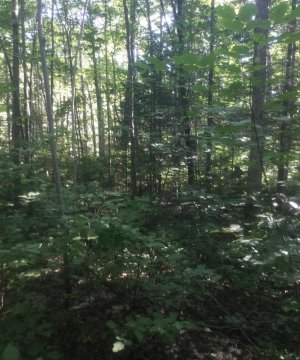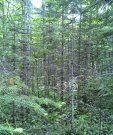Moist Loamy Lowlands
Scenario model
Current ecosystem state
Select a state
Management practices/drivers
Select a transition or restoration pathway
-
Transition T1A
Stand replacing disturbance that includes fire.
More details -
Transition T1B
Removal of forest cover and tilling for agricultural crop production.
More details -
Restoration pathway R2
Deciduous forest community is slowly invaded by conifers.
More details -
Transition T2A
Removal of forest cover and tilling for agricultural crop production.
More details -
Restoration pathway R3A
Cessation of agricultural practices leads to natural reforestation, or site is replanted.
More details -
Restoration pathway R3B
Cessation of agricultural practices leads to natural reforestation, or site is replanted.
More details -
No transition or restoration pathway between the selected states has been described
Target ecosystem state
Select a state
Description
Reference state is a forest community dominated by mixed conifers, principally balsam fir (Abies balsamea) and white spruce (Picea glauca) and scattered individuals of northern white cedar (Thuja occidentalis, or white pine (Pinus strobus), often with admixture of several deciduous species, most often trembling aspen (Populus tremuloides ), paper birch (Betula papyrifera), or red maple (Acer rubrum).
Understory vegetation, both shrub and herb layers, is well developed and diverse. Principle shrubs include beaked hazelnut (Corylus cornuta), speckled alder (Alnus incana) and red-osier dogwood (Cornus stolonifera). Herb layer typically is dominated by bracken fern (Pteridium aquilinum) and big-leaf aster (Aster macrophyllum). Other common species include wild strawberry (Fragaria virginiana), wild sarsaparilla (Aralia nudicaulis), bunchberry (Cornus Canadensis), snakeroot (Sanicula marilandica) and horsetails (Equisitum spp.).
Depending on history of disturbance, two distinct community phases can be recognized.
Submodel
Description
Pure, or mixed, aspen – paper birch community replaces the reference state community 1.1. If seed source is present, red maple readily becomes member of this community.
Submodel
Mechanism
Stand replacing disturbance that may include blow-down or ice storm, but must include fire to eliminate slash and competing vegetation and expose mineral soil to allow aspen and/or paper birch to colonize the site by seed. Alternatively, if the disrupted reference state community included aspen, the species may become re-established by vegetative means, which typically is more successful than colonization by seed.
Mechanism
Removal of forest cover and tilling for agricultural crop production.
Mechanism
Deciduous forest community is slowly invaded by conifers (balsam fir, white spruce, black spruce, white pine, white cedar) and red maple.
Mechanism
Removal of forest cover and tilling for agricultural crop production.
Mechanism
Cessation of agricultural practices leads to natural reforestation, or site is replanted.
Model keys
Briefcase
Add ecological sites and Major Land Resource Areas to your briefcase by clicking on the briefcase (![]() ) icon wherever it occurs. Drag and drop items to reorder. Cookies are used to store briefcase items between browsing sessions. Because of this, the number of items that can be added to your briefcase is limited, and briefcase items added on one device and browser cannot be accessed from another device or browser. Users who do not wish to place cookies on their devices should not use the briefcase tool. Briefcase cookies serve no other purpose than described here and are deleted whenever browsing history is cleared.
) icon wherever it occurs. Drag and drop items to reorder. Cookies are used to store briefcase items between browsing sessions. Because of this, the number of items that can be added to your briefcase is limited, and briefcase items added on one device and browser cannot be accessed from another device or browser. Users who do not wish to place cookies on their devices should not use the briefcase tool. Briefcase cookies serve no other purpose than described here and are deleted whenever browsing history is cleared.
Ecological sites
Major Land Resource Areas
The Ecosystem Dynamics Interpretive Tool is an information system framework developed by the USDA-ARS Jornada Experimental Range, USDA Natural Resources Conservation Service, and New Mexico State University.



